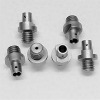James84
Member
So I began shooting black powder about a year and a half ago. Many mistakes were made in the beginning of what would become a hobby and maybe even an obsession. What i didn't think was possible has become reality, and that is that I've come to enjoy shooting bp guns more than center fire weapons.
I started with a brand new 1858 Remington which had an issue with the loading lever falling down while firing. So i did some research, bought some needle files and was able to remedy that issue with a bit of elbow grease. The gun also had a very rough action. Further research, some 400 grit sand paper, steel wool and more elbow grease made the gun really slick.
I still had issues with cap jams or cap fragments jamming up the action. More research, some slixshot nipples and problem solved! After all this effort, I could now fire the 1858 up to 120 times in a range session without a single failure, meanwhile people next to me with modern semi autos are having failures to feed, light primer strikes and a host of other malfunctions.
So at this point i've got a couple hundred rounds through the gun and still haven't really figured out how to be reliably accurate with it. After some trial and error and some filing to the front site i get her on target and am often more accurate than people next to me shooting modern hand guns.
My next screw up would be that I read how great windex with vinegar is at removing bp fouling. I somehow missed the part that it would destroy bluing... and that it did. So I soaked the gun in vinegar and brought it 100% into the white and really liked the way it looked.
Fast forward a couple hundred more rounds and the gun soaked up fouling like no other and was alot more difficult to clean after 100 round range sessions in 90% humidity weather. I tried to sand, polish and maintain it, but it didn't really seem to matter. The gun looked like crap and started to have spotted black fouling stains all over it.
So I decided that if the gun was going to look like crap, I was going to try and made it look old and weathered with some cold bluing and birchwood casey brass black. Here is how it looks today, and that is how it will stay.
The life of my 1858, 1300+ rounds later.
I started with a brand new 1858 Remington which had an issue with the loading lever falling down while firing. So i did some research, bought some needle files and was able to remedy that issue with a bit of elbow grease. The gun also had a very rough action. Further research, some 400 grit sand paper, steel wool and more elbow grease made the gun really slick.
I still had issues with cap jams or cap fragments jamming up the action. More research, some slixshot nipples and problem solved! After all this effort, I could now fire the 1858 up to 120 times in a range session without a single failure, meanwhile people next to me with modern semi autos are having failures to feed, light primer strikes and a host of other malfunctions.
So at this point i've got a couple hundred rounds through the gun and still haven't really figured out how to be reliably accurate with it. After some trial and error and some filing to the front site i get her on target and am often more accurate than people next to me shooting modern hand guns.
My next screw up would be that I read how great windex with vinegar is at removing bp fouling. I somehow missed the part that it would destroy bluing... and that it did. So I soaked the gun in vinegar and brought it 100% into the white and really liked the way it looked.
Fast forward a couple hundred more rounds and the gun soaked up fouling like no other and was alot more difficult to clean after 100 round range sessions in 90% humidity weather. I tried to sand, polish and maintain it, but it didn't really seem to matter. The gun looked like crap and started to have spotted black fouling stains all over it.
So I decided that if the gun was going to look like crap, I was going to try and made it look old and weathered with some cold bluing and birchwood casey brass black. Here is how it looks today, and that is how it will stay.
The life of my 1858, 1300+ rounds later.








